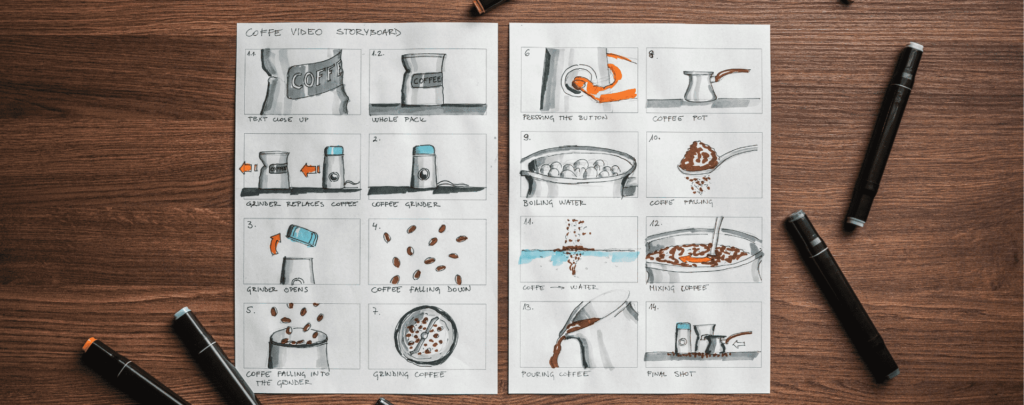
Producing a high-quality video involves more than just turning on a camera and hitting record. It requires careful planning, creativity, and attention to detail to bring a concept to life. Dragonfly, a video production company, has been in the industry for over 17 years. We will explore the step-by-step process of how to produce a video, from initial idea to final completion.
Whether you are creating a promotional video for your business, a full video editor or tutorial for your online course, or a short film, the production process of producing a video still remains the same. We will delve into topics such as developing a concept, writing a script, scouting locations, assembling a production team, filming techniques, post-production, and more.
By following these guidelines, you will gain valuable insights into producing a video that captivates your audience, communicates your message effectively, and achieves your desired goals. So, whether you are a seasoned filmmaker or a beginner venturing into video production for the first time, this article will equip you with the knowledge and tools to create compelling and professional videos.
Enter the exciting world of video production and discover the secrets to producing impactful video content that stands out from the crowd.
Understanding the video production process to produce a video

Pre-production: Planning and preparation
The pre-production phase is where the foundation for your video is laid. It involves brainstorming ideas, developing a concept, and creating a script. During this stage, it is essential to define your target audience and establish clear goals for your video. Additionally, you need to consider the logistical aspects of production, such as budgeting, scheduling, and securing necessary permits.
Once you have a clear concept and script, it’s time to assemble your production team. This includes hiring a director, cinematographer, sound engineer, and other essential crew members. Collaborating with the right professionals can make a significant difference in the overall quality of your video.
Production: Filming and capturing footage
The production phase is where the magic happens. It involves bringing your script to life by capturing footage on location or in a controlled environment. During this stage, it is crucial to choose the right equipment and technology for your specific needs. Whether you opt for a professional cinema still camera setup or a smartphone with high-quality video capabilities, the key is to ensure that your gear complements your vision. Lighting, sound, and framing are also essential factors to consider during filming.
To achieve the best results, effective communication and coordination between the director, cast, and crew are essential. This ensures that everyone is on the same page and working towards a common goal. Attention to detail and a keen eye for aesthetics will help you capture visually stunning and engaging footage.
Post-production: Editing and enhancing your video
Once you have captured all the necessary footage, the post-production phase of video strategy begins. This entire process is where the puzzle pieces come together to create a cohesive and compelling video. The editing process involves importing and organizing your footage, selecting the best shots, and arranging them in a logical and visually appealing sequence.
Editing software like Adobe Premiere Pro, Final Cut Pro, or DaVinci Resolve can assist you in refining your video. During this stage, you can add music, graphics, special effects, and transitions to enhance the overall production value. It’s important to strike a balance between creativity and simplicity, ensuring that your final video still aligns with your original concept and effectively communicates your message.
Once you are satisfied with the final cut of your video, it’s time to distribute and share it with your intended audience. Whether you choose to upload it to video-sharing platforms like YouTube or Vimeo, embed it on your website, or distribute it through other channels, make sure you optimize it for the best viewing experience.
Pre-production: Planning and preparation
Producing a video that captivates your audience and achieves your desired goals requires careful planning, attention to detail, and a creative vision. By understanding the video production process from concept to completion, you can create impactful videos that stand out from the crowd.
Remember to invest time and effort in making videos during the pre-production phase, where you develop a concept, write a script, and assemble your production team. During production, choose the right equipment, and capture visually stunning footage that aligns with your vision. In post-production, enhance your video through editing, adding music and graphics, and ensuring a seamless final product.
With these guidelines, you are well-equipped to produce high-quality videos that leave a lasting impression on your audience. So, grab your camera, unleash your creativity, and start producing the most videos, your own videos, that will make an impact in the digital world.
Assembling your production team

1. Creating a video concept and script
Before you start filming, it’s essential to have a clear concept and a well-written script. A good video or concept outlines the main idea, theme, and purpose of your video, while a script provides a detailed breakdown of the scenes, dialogue, and actions. Take the time to brainstorm ideas, conduct research, and develop a unique concept that aligns with your goals and target audience. Once you have a solid concept, write a script that effectively conveys your core message, and engages viewers.
2. Assembling your production team
Video production is a collaborative process, and assembling a skilled production team is crucial for a successful outcome. video team. Depending on the scale of your project, your team may include a director, producer, cinematographer, sound engineer, production assistant, and more. Each team member brings their expertise and contributes to the overall production value. Take the time to carefully select individuals who are not only talented but also share your vision for the whole project together.
3. Location scouting and securing necessary permits
Choosing the right locations for your video can greatly enhance its visual appeal and storytelling. Whether you’re shooting indoors or outdoors, it’s important to scout potential locations that align with your concept. Look for places that provide the desired ambiance, lighting, and accessibility. Additionally, ensure you secure any necessary permits or permissions required for filming in specific locations. This will help you avoid legal issues and ensure a smooth production process.
Location scouting and securing necessary permits
Once the pre-production stage is complete, it’s time to bring your video to life through filming and capturing footage. Here are some important considerations for a successful pre production process:
1. Choosing the right equipment and technology
Selecting the right equipment and technology is essential for capturing high-quality footage. Depending on your budget and requirements, you may choose to use professional cameras, lenses, microphones, lighting equipment, and other accessories. Familiarize yourself with the technical aspects of your equipment and conduct test shoots to ensure everything is functioning properly before the actual production. This will help you avoid any unexpected issues during filming.
2. Implementing effective filming techniques
Filming techniques play a crucial role in conveying your message and capturing engaging visuals. Consider factors such as camera angles, framing, composition, movement, and lighting to create visually appealing shots. Experiment with different techniques, such as close-ups, wide shots, tracking shots, and handheld shots, to add variety and depth to your video. Remember to also pay attention to audio quality, as clear and well-recorded sound is essential for professional video production.
3. Ensuring a smooth production process
To ensure a smooth production process, it’s important to stay organized and maintain effective communication with your production team. Create a detailed shooting and production schedule, that outlines the order of scenes, locations, and required resources. Assign specific roles and responsibilities to each team member and establish clear communication channels. Regularly review and adjust your plans as needed to ensure you stay on track and meet your production deadlines.
Production: Filming and capturing footage
The post-production stage is where your video truly comes together. This is where you can add the finishing touches, enhance the visuals and audio, and create a more polished video and final product. Here’s what you should focus on during post-production:
1. Editing your footage
Editing is the process of selecting and arranging the best shots, trimming unnecessary footage, and creating a cohesive narrative. Use professional video editing software to import your footage, organize it into a timeline, and make necessary adjustments. Experiment with different editing techniques, such as transitions, colour grading, and visual effects, to enhance the overall look and feel of your video. Remember to maintain a logical flow and maintain a pacing that aligns with your desired message.
2. Adding music, graphics, and special effects
To enhance the emotional impact and engagement of your video, consider adding music, graphics, and special effects. Choose music that complements the mood and tone of your video, and ensure you have the proper licensing rights if using copyrighted material. Incorporate graphics, such as titles, subtitles, and lower thirds, to provide context and reinforce key messages in effective video. For certain types of videos, special effects can be used to add visual interest and creativity.
3. Finalizing and distributing your video
Once your video is edited and enhanced, it’s time to finalize and distribute it. Export your video in the appropriate format and resolution for the intended platform or audience. Consider optimizing your video for different devices and platforms, such as mobile devices, social media platforms, or websites. Develop a video distribution and marketing strategy that includes sharing your video on relevant platforms, promoting it through social media, and leveraging your existing network to reach your target audience.
Choosing the right equipment and technology
Choosing the right equipment and technology is a critical aspect of your journey to produce a video that stands out. To produce a video effectively, you need to consider your budget, the nature of your project, and your technical proficiency. High-quality cameras, microphones, lighting setups, and editing software can make a significant difference in the final product. It’s essential to match your equipment to the specific requirements of your project, ensuring that you capture clear, professional-grade footage. Whether you’re producing a video for a corporate presentation, a vlog, or a creative endeavor, investing in the right technology is key to producing a video that meets or exceeds your audience’s expectations.
Post-production: Editing and enhancing your video production process
Producing a video starts with the actual filming and capturing of footage. This is where your vision comes to life. To ensure a smooth production process, it is essential to choose the right equipment and technology for your video project though.
When selecting a camera, consider factors such as resolution, frame rate, and lens options. High-resolution cameras like DSLRs or mirrorless cameras offer better image quality, while professional cinema cameras provide advanced features for more control over your shots. Additionally, consider investing in quality lenses that suit the type of shots you want video camera to capture.
In addition to a camera, you’ll need other essential equipment such as tripods, stabilizers, and lighting. Tripods provide stability and help eliminate shaky footage, while stabilizers like gimbals or steadicams allow for smooth tracking shots. Proper lighting is crucial for creating the right atmosphere and ensuring your subjects are well-lit and visible.
Once you have your video equipment all ready, it’s time to scout locations. Whether you’re shooting indoors or outdoors, the right location can greatly enhance the visual appeal of your video. Consider factors such as lighting, acoustics, and accessibility when choosing a location. If you’re filming on private property, make sure to obtain the necessary permits or permissions.
During the filming process, it’s important to consider different techniques and angles to make your video visually interesting. Experiment with techniques like panning, zooming, and tracking shots to add dynamism to your footage. Additionally, vary your camera angles by using high and low shots, as well as close-ups and wide shots, to create visual depth and capture the viewer’s attention.
Remember to communicate effectively with your production team and cast to ensure everyone is on the same page. Provide clear instructions and be open to creative input from others. This collaborative approach will result in a more cohesive and engaging final product.
Adding music, graphics other videos, and special effects
Once you’ve captured all the raw footage above, it’s time to move on to the post-production phase. This is where you transform raw video footage into a polished and cohesive video that effectively communicates your message.
The first step in post-production is to transfer your footage to a computer or external storage device. Use video editing software such as Adobe Premiere Pro, Final Cut Pro, or DaVinci Resolve to import and organize your footage. These editing tools offer a wide range of features for trimming, arranging, and enhancing your video clips.
Start by creating a rough cut of your video. This involves selecting the best takes and extra footage and arranging them in a logical sequence. Consider the flow of the narrative and ensure that each shot contributes to the overall story you want to tell. Trim unnecessary footage and make smooth transitions between scenes to maintain a seamless viewing experience.
Once you have a rough cut, it’s time to refine your video. This includes adjusting the colour grading to create the desired mood or atmosphere. Use colour correction tools to balance the colours in each shot and enhance the overall visual appeal. Additionally, consider adding visual effects or graphics to enhance specific scenes or convey additional information.
Sound design is another crucial aspect of post-production. Clean up any background noise, adjust the volume levels, and add music or sound effects to enhance the overall audio experience. The right soundtrack can evoke emotions, create suspense, add graphics, or set the tone for your video.
After finalizing the editing and enhancing process, it’s time to export your finished video, in the appropriate format for distribution. Consider the platform or medium on which your video will be displayed and export it accordingly. For online platforms, such as YouTube or Vimeo, consider using H.264 or H.265 codecs for optimal streaming quality.
Finalizing and distributing your video production process
Congratulations! You’ve successfully produced and polished your video. Now it’s time to share it with the world.
Before distributing your video, make sure to review it one final time to ensure there are no errors or inconsistencies. Check for any spelling mistakes, audio glitches, or visual artefacts that may have been missed during the editing process. It’s always a good idea to have a fresh pair of eyes review your video as well, as they may catch things you might have overlooked.
Once you’re satisfied with the final product, decide on the distribution channels for your video. Consider your target audience and the platforms they frequent. Social media platforms like Facebook, Instagram, and LinkedIn offer great opportunities for reaching a wide audience. Additionally, consider embedding your video on your website or sharing it with industry-specific platforms or communities.
To maximize the reach and impact of your video, create a promotional plan. This may include creating teaser clips or trailers to generate excitement, reaching out to influencers or industry experts for collaborations, or utilizing paid advertising to target specific demographics. A well-thought-out promotional strategy can greatly increase the visibility and engagement of your video.
In conclusion, producing a video requires careful planning, attention to detail, and creativity. By following the step-by-step process outlined in this article, you can produce high-quality videos that captivate your audience, communicate your message effectively, and achieve your desired goals. From developing a concept to finalizing and distributing your video, each stage plays a crucial role in creating compelling and professional content. So, grab your camera, unleash your creativity, and start producing videos that leave a lasting impact.



















